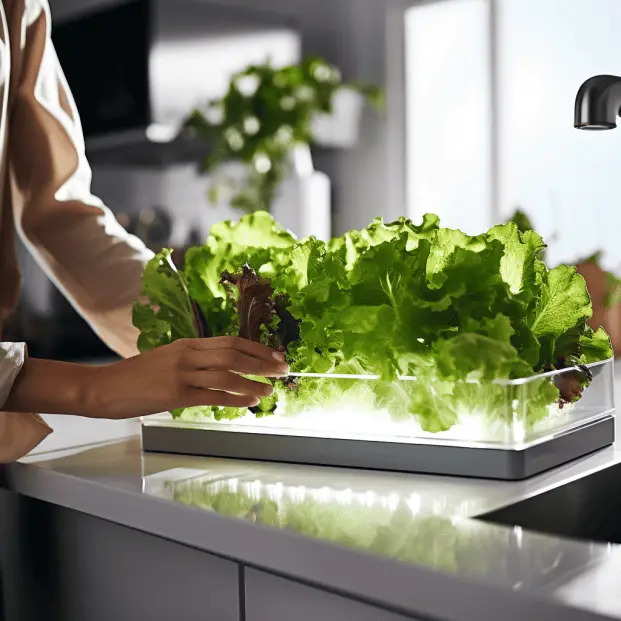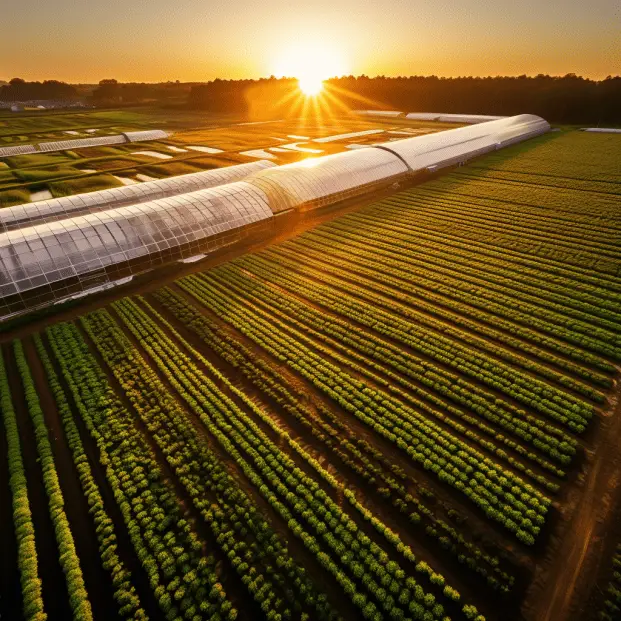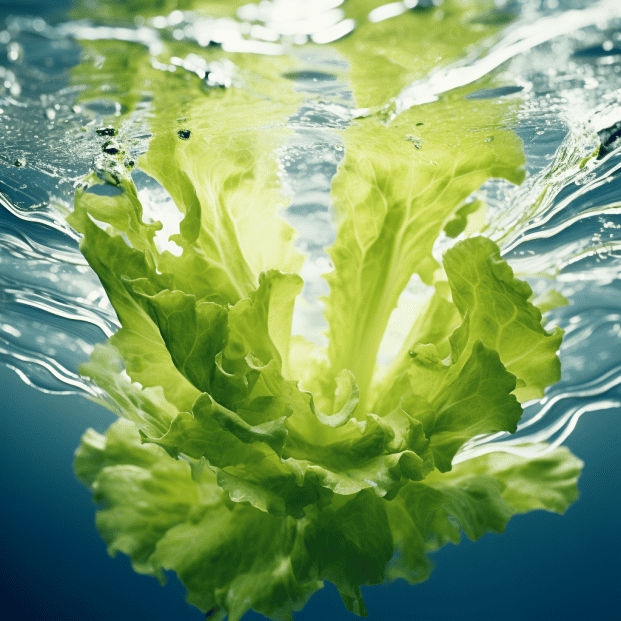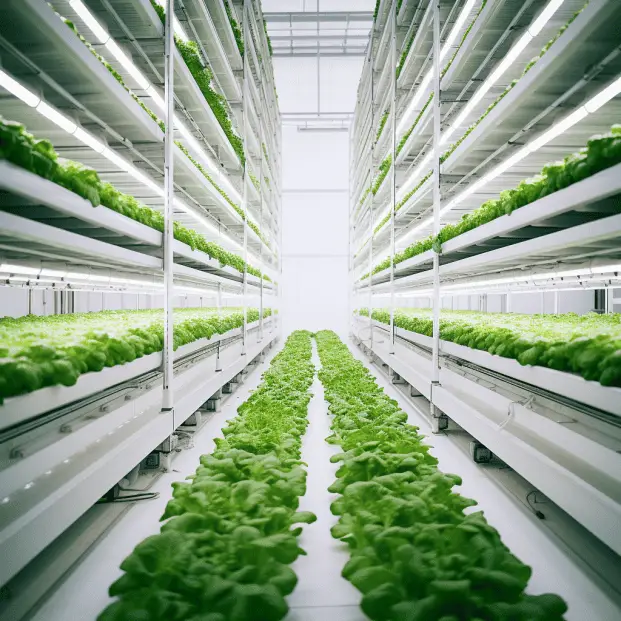According to urban farmer John, “Hydroponic lettuce offers rapid, consistent growth and higher yields without the need for soil.”
With concerns over land and water usage in agriculture, hydroponics presents an innovative solution.
This method of growing lettuce uses 95% less water than traditional farming while maximizing crop production.
As populations expand, finding sustainable ways to grow fresh produce is crucial.
Hydroponic lettuce is nutritious, eco-friendly, and space-efficient, making it ideal for our future food needs.
Keep reading to learn how hydroponic lettuce works and the benefits it provides.
Discover how to start your own soilless lettuce garden to enjoy bountiful, mineral-rich greens.
KEY TAKEAWAY
Hydroponic lettuce, what to know?
Hydroponic plant such as lettuce is a soilless, sustainable farming method that yields exceptionally fresh and clean produce, free from soil-borne contaminants and with minimal environmental impact. (1)
How to Grow Hydroponic Lettuce
Growing lettuce hydroponically allows you to harvest fresh, crisp greens year-round right from your own home.
While it may seem intimidating, setting up a simple hydroponics system for lettuce is actually pretty straightforward.
The keys are choosing the right equipment, nutrients, and lettuce varieties for your needs.
When growing hydroponic lettuce, the nutrient solution provides all the water and food the plants need to thrive.
This eliminates the need for soil.
The roots absorb the nutrients directly from the water.
Hydroponic systems come in different types like deep water culture, drip systems, aeroponics, NFT channels, and more.
But for lettuce, a basic ebb and flow or drip system works great.
Let’s explore the step-by-step process for hydroponic lettuce growing success!
Planting Lettuce Hydroponically Guide

Starting with lettuce seeds? Here are some tips for planting in a hydroponic system: (2)
- Choose a fast-growing variety like oak leaf, butterhead or red leaf. Slow-growers like romaine can take too long.
- Start seeds in net pots, rockwool cubes or Oasis root cubes. This lets roots grow through for easier transplanting.
- Use a heat mat to maintain 75°F soil temperature for better germination.
- Place seedlings under grow lights (LEDs or fluorescents). Lettuce needs 16-18 hours of light per day.
- Transplant into the hydroponic system after 2-3 weeks once the first true leaves appear.
If buying lettuce transplants, look for young plants about 3-4 inches tall.
Gently loosen the root ball and place into growing medium like clay pebbles or perlite.
Water immediately to avoid transplant shock.
Give lettuce transplants 16-18 hours of light per day.
Daytime temperatures of 65-75°F are ideal.
Protect plants from direct hot sunlight.
Provide adequate water, nutrients, and airflow.
Lettuce thrives in humidity around 70%.
Growing Lettuce Hydroponically with Care: Light, Water, and Temperature

Caring for hydroponic lettuce is all about monitoring light, water and temps.
Here are some top tips:
Lighting – Lettuce needs 16-18 hours of bright light per day. LED grow lights work great and don’t put off much heat. Place lights 6-12 inches above plants.
Water – Check pH (5.5-6.5) and EC (1.2-1.6) levels daily. Top off nutrient reservoir as needed. Change solution completely every 2 weeks.
Temperature – Daytime temps of 65-75°F and nights around 60°F are ideal. Use fans for airflow and prevent fungal issues.
Make adjustments based on the stage of growth.
Seedlings need more humidity and Protection from direct light.
As plants mature, increase light intensity and air circulation.
Monitor closely to catch any problems early!
Selecting Growing Mediums, Nutrients, and Hydroponic Systems

When growing hydroponically, you’ll need to choose suitable growing mediums and nutrient solutions.
Growing Mediums: Clay pebbles, perlite, vermiculite, rockwool and coconut coir work well for lettuce. Look for mediums that hold some water but still drain well. Reusable clay pebbles are a popular hydroponic medium.
Nutrients: Lettuce has lower nutrient needs than fruiting plants. Use a specialty lettuce formula or balanced vegetative solution. Look for NPK ratios like 7-4-10 or 5-5-5. Add nutrients like Cal-Mag to prevent deficiencies.
Hydroponic Systems: Deep water culture, drip systems, NFT channels, and ebb and flow systems all work for lettuce. Make sure to provide oxygenation. Lettuce likes consistent moisture but stagnant roots will rot.
Avoid overfeeding lettuce with nutrients.
Start around 300 PPM and increase to 500 PPM gradually as plants mature.
Always follow label instructions for mixing nutrient solutions.
Exploring Lettuce Varieties
One of the fun parts about growing hydroponically is trying different types of lettuce!
Some top options include:
- Butterhead Lettuce – Tender leaves, sweet flavor. Grow Bibb, Boston, and Buttercrunch.
- Leaf Lettuce – Frilly, loose leaves. Try Green Oakleaf, Red Sails, Black-seeded Simpson.
- Romaine – Crunchy with sturdy ribs. Grow Hearts, Little Caesar, Paris Island.
- Summer Crisp – Heat tolerant. Plant Magenta, Concept, Nevada.
- Mesclun – Blend for salads. Combine lettuces like arugula, endive, radicchio.
- Specialty – Unique varieties like limestone, mache, tango.
Mix up loose leaf and head lettuce types.
Stagger planting times for continual harvests.
Choose your lettuce variety, and taste test new varieties to find your favorites!
Harvest and Store Hydroponic Lettuce
Determining when and how to harvest lettuce ensures you enjoy maximum freshness and flavor.
Follow these lettuce harvesting tips:
- Harvest leaf lettuce individually when outer leaves are 4-6 inches long. Romaine heads are ready at 8-10 inches tall.
- Harvest butterhead once the head feels full and firm. Cut the entire head above the root.
- Use a clean, sharp knife or scissors. Cut in mornings for optimal flavor.
- Store freshly cut lettuce in a bowl with a damp paper towel in the fridge. Use within 5-7 days.
- Rinse and dry lettuce well before storing. Remove any slimy or spoiled outer leaves.
- Lettuce can also be blanched and frozen for longer storage. Portion into freezer bags.
Enjoy your homegrown lettuce within a few days for best quality.
Try making crispy salads, tasty wraps, juicy burgers and more!
Health Benefits of Hydroponic Lettuce
Cultivating lettuce hydroponically allows you to harvest the healthiest, most nutritious greens possible.
Hydroponic lettuce offers many benefits:
- Higher vitamin and antioxidant levels since plants aren’t stressed.
- No pesticides or chemicals used unlike store-bought lettuce.
- Leaves stay fresher longer with quick delivery from garden to plate.
- Convenient source of leafy greens to boost nutrition in your diet.
Lettuce provides antioxidants like beta-carotene, lutein and zeaxanthin.
It’s also rich in vitamin C, potassium, folate and fiber yet low in calories.
Romaine has lots of vitamin K.
Red leaf is packed with vitamin A.
Eating lettuce can help lower cholesterol, blood pressure and inflammation.
The fiber aids digestion and weight loss.
So grow your own lettuce hydroponically for better health!
Frequently Asked Questions
How do I grow hydroponic lettuce?
Growing hydroponic lettuce can be very rewarding.
The basic steps are to select your lettuce variety, start with seedlings or transplants, provide the optimum growing conditions including light, water, nutrients and temperature control, and harvest your lettuce.
Be sure to choose a variety that grows best in your hydroponic system.
What types of lettuce can I grow hydroponically?
Common types of lettuce grown hydroponically include romaine lettuce, leaf lettuce, butterhead lettuce, bibb lettuce, and loose leaf lettuce.
Iceberg lettuce can also be grown but the outer leaves may not develop as well hydroponically.
Experiment to see which variety of lettuce is best suited for your hydroponic garden.
How long does it take for lettuce to grow hydroponically?
The time it takes for lettuce plants to mature depends on the variety but most romaine lettuce, leaf lettuce and loose leaf varieties will be ready to harvest within 3-4 weeks.
Butterhead and bibb lettuce may take a few days longer.
Make sure to provide optimal growing conditions like consistent temperatures, adequate light levels, and a balanced nutrient solution to achieve rapid plant growth.
What is the best way to start lettuce from seed or transplant?
You can start lettuce from seed directly in your hydroponic system, or use lettuce seedlings.
Starting with seedlings gives your plants a head start but direct seeding is also effective.
When direct seeding, use seed starting mix and keep the seeds moist in a germination chamber until the seedlings have emerged.
Transplant appropriately sized seedlings, making sure not to damage the plant roots.
What are the best conditions for growing hydroponic lettuce?
Ideal conditions for growing hydroponic lettuce include temperatures between 65-75°F, a minimum of 1500-2000 foot-candles…
…of full-spectrum light for 16 hours per day, and a nutrient solution formulated for leafy greens with an electrical conductivity of 1.2-1.5 mS/cm and a water temperature between 65-70°F.
Maintaining consistent controlled environments will result in rapid lettuce growth and production.
What type of hydroponic system is best for growing lettuce?
Many hydroponic growers have success producing lettuce with ebb and flow (flood and drain) systems, deep water culture (DWC) systems, and nutrient film technique (NFT) systems.
Experiment to see which system allows your lettuce varieties to thrive best.
Ebb and flow systems are easy to use for beginners.
DWC systems can accommodate high plant densities for large-scale leafy green production.
How do I know if my lettuce is getting enough nutrients?
Watch for strong green growth, no discoloration of the plant leaves, and quick plant growth.
You can also test the electrical conductivity and pH of your nutrient solution, aiming for an EC of 1.2-1.5 mS/cm and a pH of 5.5-6.5.
Lettuce showing pale leaves, tip burn or yellowing may not be receiving adequate nutrients and you should check your water and nutrient levels.
Adjust as needed following hydroponic crop nutrient guidelines.
Is hydroponic lettuce more nutritious than soil-grown lettuce?
Research on the nutritional content of hydroponically grown lettuce compared to soil-grown lettuce has had mixed results.
In controlled environment studies, hydroponically grown lettuce may have higher levels of certain vitamins and minerals like Vitamin C, potassium and magnesium.
However, nutrition can vary depending on lettuce variety and exact growing conditions.
Both soil and hydroponic methods can produce highly nutritious loose leaf and romaine lettuce when grown under optimum conditions.
What are some tips for harvesting hydroponic lettuce?
For loose leaf lettuce varieties, harvest individual outer leaves by cutting them from the base of the plant with scissors.
This allows the inner leaves to continue growing.
For head lettuce like romaine, cut the entire head about 1/2 inch above the root mass once mature.
Harvest in the morning after lights have been on for a few hours.
Hydroponically grown lettuce may have a slightly longer shelf life than soil-grown lettuce once harvested.
How can I protect my hydroponic lettuce from pests and diseases?
Some best practices to help prevent pests and diseases in your hydroponic lettuce include…
….maintaining clean growing equipment, using disease-free transplants or…
… seeds, checking plants regularly for signs of issues, and controlling environmental factors like temperature, humidity, light and nutrients.
Careful sanitation helps avoid introducing pathogens, and choosing lettuce varieties with disease resistance can reduce risks for your hydroponic garden.
Monitor plants closely and isolate any showing issues.
Conclusion
In summary, hydroponic lettuce offers faster growth, higher yields, and year-round production without soil.
With the right equipment and nutrient monitoring, hydroponically grown lettuce achieves excellent quality and consistency.
However, these systems do require more inputs than traditional farming.
For urban farmers or vertical operations, investing in a well-designed hydroponic lettuce setup can be highly profitable.
Home gardeners may start small to gain experience before scaling up.
Either way, growing fresh, local lettuce hydroponically lets you enjoy harvests in record time.
Hydroponic lettuce uses 95% less water than soil-based farming, making it a sustainable option as populations grow.
Ensuring food security in the future means embracing innovative solutions.
Let me know if you have any other questions! What interests you most about hydroponic lettuce?
References
- https://www.edengreen.com/blog-collection/hydroponic-butterhead-lettuce
- https://www.wikihow.com/Grow-Hydroponic-Lettuce
Related Articles
- https://tophydroponicgarden.com/hydroponic-plants/
- https://tophydroponicgarden.com/what-materials-do-you-need-for-hydroponics/
- https://tophydroponicgarden.com/ebb-and-flow-system-guide/
Was this helpful?

I’m Barrie L., a passionate hydroponic gardening enthusiast dedicated to cultivating thriving, soil-less gardens. With a focus on all things hydroponic, I share my expertise on innovative growing techniques and sustainable practices through my blog, tophydroponicgarden.com. As a seasoned hydroponics specialist, my goal is to inspire and guide fellow gardeners in harnessing the power of water-based cultivation for bountiful and eco-friendly harvests. I’m also an author of the book “Hydroponics For Absolute Beginners: Your Step By Step Guide For How To Create An Hydroponics System At Home Without Soil, For Growing Vegetable, Fruit And Herbs.” which is sold on Amazon. Join me on a journey of redefining the way we cultivate plants, one nutrient-rich solution at a time. Happy growing!


